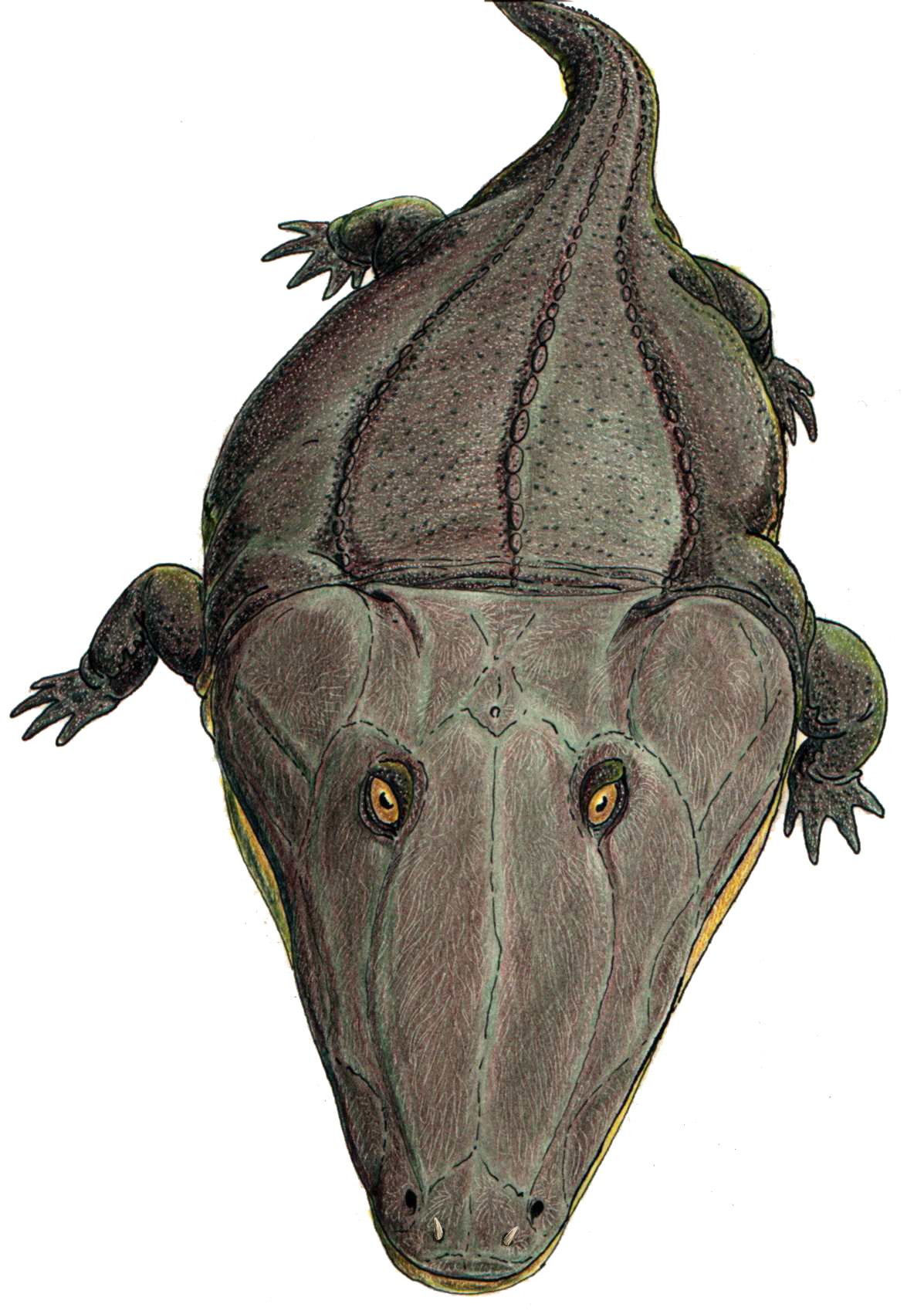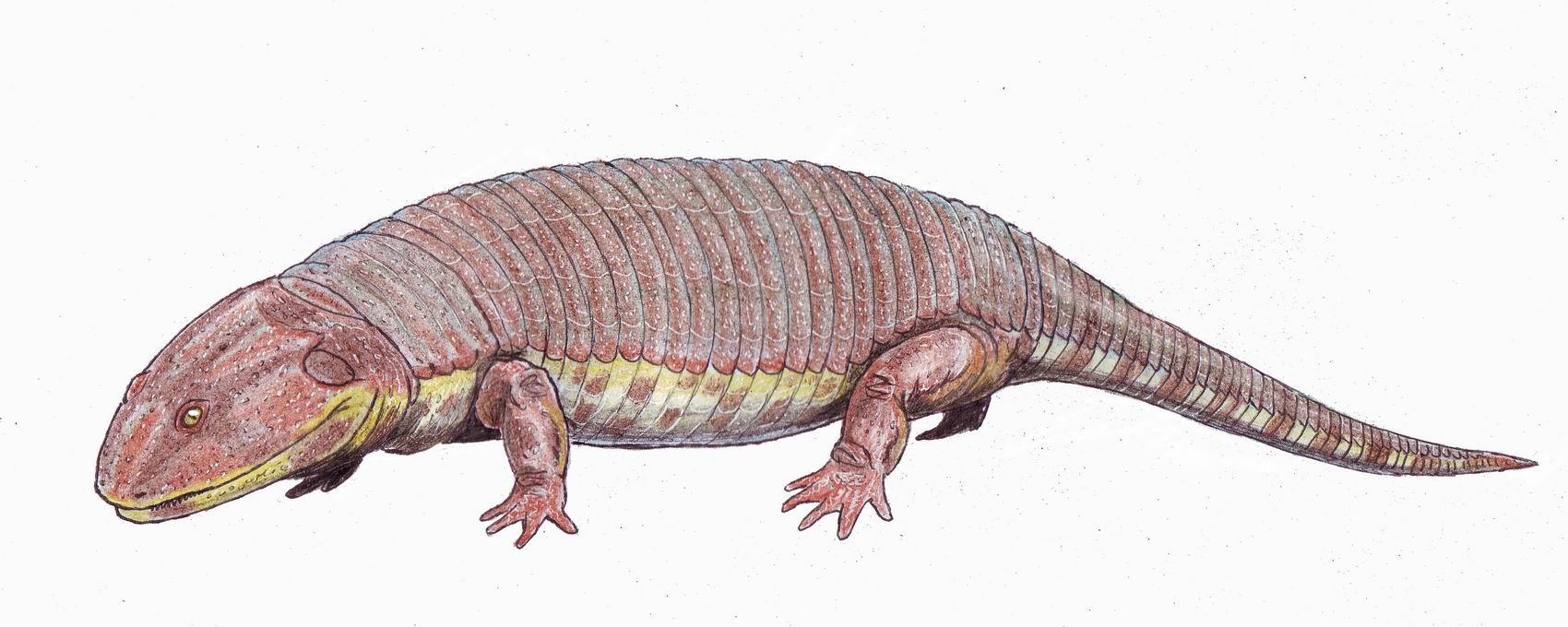|
Vladlenosaurus
''Vladlenosaurus'' is an extinct genus of capitosaurian temnospondyl from Russia. It lived during the late Vetlugian (Early Triassic). Based on the type of deposits it was found in, ''Vladlenosaurus'' probably inhabited Lake, lacustrine, or lake, habitats. The type species is ''V. alexeyevi'', named in 2000. Description Unlike the flatter, more rounded snouts of other capitosaurs, ''Vladlenosaurus'' had a wedge-shaped snout. This characteristic is also seen in trematosaurians, although it was independently acquired in both cases as a result of convergent evolution. Classification ''Vladlenosaurus'' is similar in appearance to the Benthosuchus, benthosuchids, a group of Trematosauroidea, trematosauroid temnospondyls, but is more closely related to Mastodonsauroidea, mastodonsauroids. Among capitosaurs, it shares many features with the basal (phylogenetics), basal form ''Wetlugasaurus'', also from the Early Triassic of Russia. ''Vladlenosaurus alexeyevi'' was even considered to be ... [...More Info...] [...Related Items...] OR: [Wikipedia] [Google] [Baidu] |
Benthosuchus
''Benthosuchus'' (meaning "deep water crocodile") is an extinct genus of temnospondyli, temnospondyl amphibian from the Early Triassic of Russia. It was primarily aquatic, living in rivers and lakes. Multiple species are known, with the largest reaching about 2.5 meters in length. Russian paleontologist Ivan Yefremov [Efremov] called the genus ''Benthosaurus'' "deep water lizard" (from Ancient Greek βένθος (''benthos'') "depth, deep water") in his original 1929 description, "in view of its clearly indicated adaptation to life in deep water" shown by "the position of the orbits and the flatness of the skull." The type species ''B. sushkini'' honored his late teacher Petr Sushkin. The generic name was preoccupied by ''Benthosaurus'' Goode & Bean, 1886, a fish, and he renamed the genus ''Benthosuchus'' ("deep water crocodile") in 1937.Efremov, I. A. (1929). ''Benthosaurus sushkini'', ein neuer Labyrinthodont der permotriassischen Ablagerungen der Sharschenga Flusses. ''Bull ... [...More Info...] [...Related Items...] OR: [Wikipedia] [Google] [Baidu] |
Capitosauria
Capitosauria is an extinct group of large temnospondyl amphibians with simplified stereospondyl vertebrae. Mainly living as piscivores in lakes and rivers, the Capitosauria and its sister taxon Trematosauria were the only major labyrinthodonts that existed during the Mesozoic in ecological niches broadly similar to those of modern crocodiles, and some grew to very large sizes. At 6 meters in length, the Mid-Triassic '' Mastodonsaurus giganteus'' is not only thought to have been the largest capitosaur, but possibly also the largest amphibian to have lived. The latest known remains are from the Rhaetian of Germany and are referred to '' Cyclotosaurus''. Capitosauria was first named by Schoch and Milner (2000) and further described by Yates and Warren (2000), who assigned ''Lydekkerina'' and Mastodonsauroidea to it. It was described by Damiani (2001) under the name Mastodonsauroidea. In their phylogenetic analysis of temnospondyls, Ruta ''et al.'' (2007) placed ''Lydekkerina'' and ... [...More Info...] [...Related Items...] OR: [Wikipedia] [Google] [Baidu] |
Odenwaldia
''Odenwaldia'' is an extinct genus of mastodonsauroid temnospondyl within the family Heylerosauridae. History of study ''Odenwaldia'' is only known from one species, ''O. heidelbergensis'', and was named by Morales & Kamphausen (1984). The holotype, a skull roof and counterpiece cast, were collected from the Middle Bundsandstein (Oberes Konglomerat) near Heidelberg, Germany and were first described by Wilhelm Simon in 1961, who thought that the specimen belonged to the trematosaur ''Trematosaurus''. It was then redescribed by Schoch (2008). Description The holotype is the only uncontroversial specimen of this taxon, although others have been referred to the species. ''Odenwaldia'' is diagnosed by several autapomorphies, including (1) small orbits combined with broad interorbital distance; (2) preorbital region slender, with nasals and lacrimals narrower than frontals; and (3) dermal ornament consists of small, similarly sized polygons, but no elongated ridges. In contrast ... [...More Info...] [...Related Items...] OR: [Wikipedia] [Google] [Baidu] |
Wetlugasaurus
''Wetlugasaurus'' (meaning "Vetluga River lizard") is an extinct genus of temnospondyl from the Early Triassic (Olenekian) Charkabozh, Kzylsaiskaya, Petropavlovka, Kamennyi Yar and Vetluga Series Formations of northern Russia and Greenland. It had a long skull, and reached a total length of . Phylogeny ''Wetlugasaurus'' in a cladogram A cladogram (from Greek language, Greek ''clados'' "branch" and ''gramma'' "character") is a diagram used in cladistics to show relations among organisms. A cladogram is not, however, an Phylogenetic tree, evolutionary tree because it does not s ... after Novikov (2018) with only Early Triassic Eastern Europe taxa included: References Further reading * ''The Age of Dinosaurs in Russia and Mongolia'' by Michael J. Benton, Mikhail A. Shishkin, David M. Unwin, and Evgenii N. Kurochkin. p. 35-59. * ''Bibliography Of Fossil Vertebrates 1934-1938'' by C. I. Camp Capitosauria Triassic temnospondyls of Europe Olenekian life ... [...More Info...] [...Related Items...] OR: [Wikipedia] [Google] [Baidu] |
Edingerella
''Edingerella'' is an extinct genus of temnospondyl amphibian from the Early Triassic of Madagascar. It is a basal capitosaur closely related to ''Watsonisuchus''. Phylogeny Below is a cladogram A cladogram (from Greek language, Greek ''clados'' "branch" and ''gramma'' "character") is a diagram used in cladistics to show relations among organisms. A cladogram is not, however, an Phylogenetic tree, evolutionary tree because it does not s ... from Fortuny et al. (2011): References Capitosauria Triassic temnospondyls of Africa Prehistoric animals of Madagascar Early Triassic amphibians of Africa {{temnospondyli-stub ... [...More Info...] [...Related Items...] OR: [Wikipedia] [Google] [Baidu] |
Lydekkerina
''Lydekkerina'' is an extinct genus of stereospondyl temnospondyl. It is the type genus of the family Lydekkerinidae. Fossils have been collected from Early Triassic deposits in South Africa and Australia. The type species is '' L. huxleyi'', first described in 1889. While most other stereospondyls were semiaquatic, ''Lydekkerina'' was exclusively terrestrial. Description ''Lydekkerina'' was a relatively small temnospondyl, growing up to around in length. Skulls range in length from in the smallest known individual to up to in larger individuals. The skull is wedge-shaped and has a parabolic outline with convex lateral margins. Shallow pits cover the surface of the skull. Teeth line the palate as well as the jaws, and some skulls even bear large ectopterygoid tusks on the underside of the skull. ''Lydekkerina'' can be distinguished from other lydekkerinids on the basis of several skull characteristics. One such feature is the presence of vomerine shagreen, tiny bumps cover ... [...More Info...] [...Related Items...] OR: [Wikipedia] [Google] [Baidu] |
Rhinesuchidae
Rhinesuchidae is a family (biology), family of Tetrapoda, tetrapods that lived primarily in the Permian period. They belonged to the broad group Temnospondyli, a successful and diverse collection of semiaquatic tetrapods which modern amphibians are probably descended from. Rhinesuchids can be differentiated from other temnospondyls by details of their skulls, most notably the interior structure of their otic notches at the back of the skull. They were among the earliest-diverging members of the Stereospondyli, a subgroup of temnospondyls with flat heads and aquatic habits. Although more advanced stereospondyls evolved to reach worldwide distribution in the Triassic period, rhinesuchids primarily lived in the high-latitude environments of Gondwana (what is now South America and Africa) during the Permian, Guadalupian and Permian, Lopingian epochs of the Permian. The taxonomy (biology), taxonomy of this family has been convoluted, with more than twenty species having been named in t ... [...More Info...] [...Related Items...] OR: [Wikipedia] [Google] [Baidu] |
Xenotosuchus
''Xenotosuchus'' is an extinct genus of mastodonsaurid temnospondyl within the family Mastodonsauridae known from the Triassic of South Africa. The genus is based on a skull originally described as ''Parotosuchus'', an animal which it resembled in general build and habit. Description Like many mastodontosaurids, it was a large animal with a large head. Its amphibian life history meant that the distinct shape of the skull roof would change from a generalized tadpole-like skull type through to the distinct adult shape. The head bones are covered in large pits and grooves, indicating extensive dermal armour on the head. Both the upper and lower jaw had tusks, those of the upper jaw being situated on a 2nd row of teeth on the vomer and palatine bone. Contrary to related forms like ''Mastodonsaurus'', the tusks of the lower jaw were of moderate size and did not penetrate the premaxilla. See also * Prehistoric amphibian * List of prehistoric amphibians This list of prehistoric amph ... [...More Info...] [...Related Items...] OR: [Wikipedia] [Google] [Baidu] |
Watsonisuchus
''Watsonisuchus'' is an extinct genus of temnospondyl from the Early Triassic of Australia, Madagascar, and South Africa. It was up to 122 cm long and had a robust skull of 24 cm in length. Three or four species are known:'Dragons in the Dust: The Paleobiology of the Giant Monitor Lizard Megalania'' by Ralph E. Molnar (Pg. 39) ''W. magnus'' (the type species In International_Code_of_Zoological_Nomenclature, zoological nomenclature, a type species (''species typica'') is the species name with which the name of a genus or subgenus is considered to be permanently taxonomically associated, i.e., the spe ...), ''W. aliciae'' (which may instead belong to '' Warrenisuchus''), ''W. gunganj'', and ''W. rewanensis''. References Capitosauria Triassic temnospondyls of Africa Triassic temnospondyls of Australia Early Triassic amphibians of Africa Fossil taxa described in 1966 {{Temnospondyli-stub ... [...More Info...] [...Related Items...] OR: [Wikipedia] [Google] [Baidu] |
Stereospondyl
The Stereospondyli are a group of extinct temnospondyl amphibians that existed primarily during the Mesozoic period. They are known from all seven continents and were common components of many Triassic ecosystems, likely filling a similar ecological niche to modern crocodilians prior to the diversification of pseudosuchian archosaurs. Classification and anatomy The group was first defined by Zittel (1888) on the recognition of the distinctive vertebral anatomy of the best known stereospondyls of the time, such as ''Mastodonsaurus'' and ''Metoposaurus''. The term 'stereospondylous' as a descriptor of vertebral anatomy was coined the following year by Fraas, referring to a vertebral position consisting largely or entirely of the intercentrum in addition to the neural arch. While the name 'Stereospondyli' is derived from the stereospondylous vertebral condition, there is a diversity of vertebral morphologies among stereospondyls, including the diplospondylous (' tupilakosaurid') co ... [...More Info...] [...Related Items...] OR: [Wikipedia] [Google] [Baidu] |
Cherninia
''Cherninia'' is an extinct genus of mastodonsaurid temnospondyl known from the Denwa Formation of India and the Ntawere Formation of Zambia. Discovery and species The type species, ''Cherninia denwai'', is known from the Denwa Formation. It is based on a massive skull, ISI A 54, which was originally considered a species of ''Parotosuchus'' in 1998 before being given its own genus in 2001. Another species, ''Cherninia megarhina'', is known from the Upper Ntawere Formation. ''C. megarhina'' is based on another large skull, BP/1/4223, which had also been previously referred to ''Parotosuchus''. Though not as well-preserved as the skull of ''C. denwai'', BP/1/4233 was described earlier in 1974. It was described by Sharon Chernin, a paleontologist at the Bernard Price Institute and the namesake of the genus. Description ''Cherninia denwai'' was initially described on the basis of cranial material from the Denwa Formation. A redescription in 2024 described new material from th ... [...More Info...] [...Related Items...] OR: [Wikipedia] [Google] [Baidu] |



